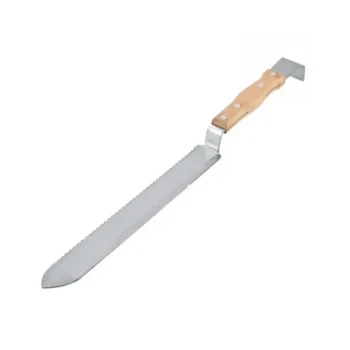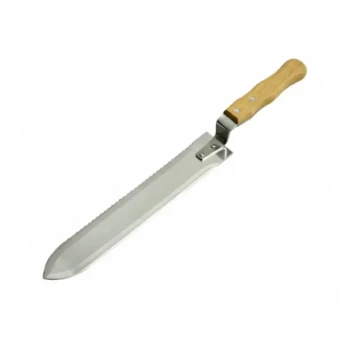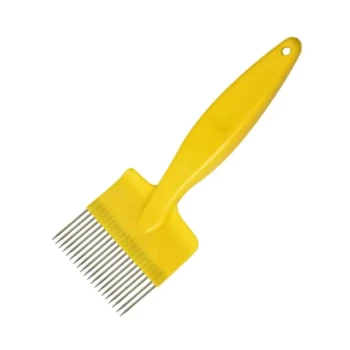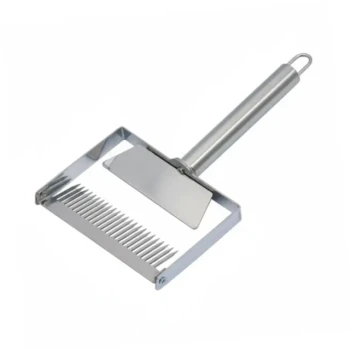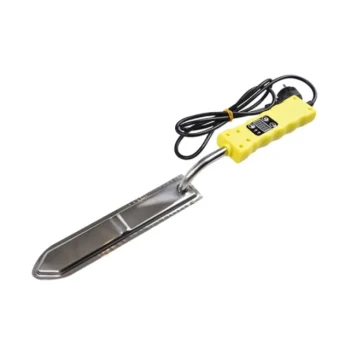Yes, comb depth is a critical factor in determining the efficiency of an uncapping tool. The thickness and uniformity of the honeycomb directly impact how easily and cleanly a tool can remove the wax cappings. Matching the tool to the comb depth is essential for an efficient honey harvest.
The core principle is simple: as comb depth increases, the ideal tool shifts from one of precision (fork) to one of speed and power (plane). Using the wrong tool for your comb's specific depth will result in wasted time, damaged combs, and a more difficult harvest.
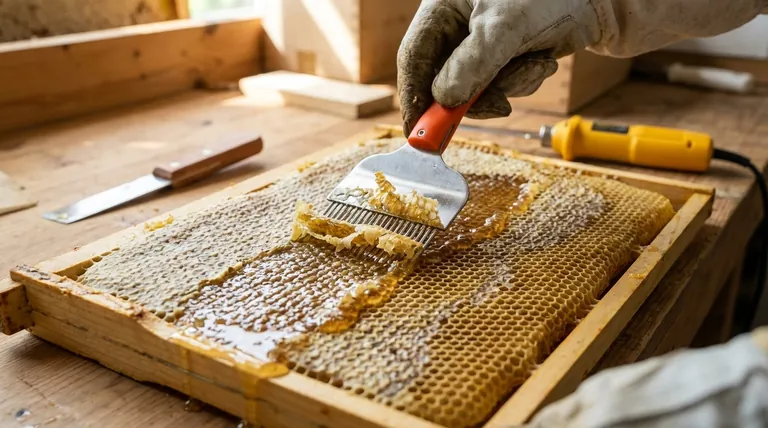
Why Comb Depth Dictates Your Tool Choice
The goal of uncapping is to remove only the thin layer of wax sealing the honey cells. The depth and evenness of this wax surface present the primary challenge.
The Geometry of the Comb
Honeycombs are rarely perfectly flat. Shallow combs often have low spots or uneven surfaces that a large blade can miss.
Conversely, very deep combs present a thick, uniform surface of wax that can be removed in a single, clean pass with the right tool.
Balancing Speed, Effort, and Precision
Each uncapping tool represents a different balance of these three factors. A precise tool may be slow, while a fast tool may require more skill to avoid damaging the comb.
Your comb depth determines which balance will be most effective for you.
A Tool-by-Tool Guide for Every Comb Depth
Each tool is designed to excel under specific conditions. Understanding these design intentions is key to selecting the right one for your frames.
Shallow Combs: The Uncapping Fork
The uncapping fork (or scratcher) is the ideal tool for shallow or uneven combs.
Its tines allow for precise work, letting you get into low areas that a knife would glide over. While it is the most time-consuming method, it provides the most control and minimizes damage to the comb structure.
Medium Combs: The Electric Knife
An electric knife, with its heated blade, excels on medium-depth combs that are relatively uniform.
The heat melts the wax as it cuts, allowing the knife to glide through with minimal physical effort. This makes it significantly faster than a fork for standard, well-drawn-out frames.
Deep Combs: The Cold Knife
A cold knife, which is typically serrated and requires a sawing motion, is highly effective on deep combs.
The thicker wax on these combs provides enough purchase for the knife to make a clean, consistent cut without the blade getting bogged down. It offers more control than a heated knife on very thick cappings.
Very Deep Combs: The Uncapping Plane
For very deep, uniform combs, typically found in large-scale commercial operations, the uncapping plane is the most efficient choice.
Much like a wood plane, it shaves off the top layer of cappings in a single, swift pass. This tool is built for high volume and speed but requires consistent comb surfaces to be effective.
Understanding the Trade-offs
Choosing a tool is not just about its advantages; it's also about understanding its limitations.
The Fork's Hidden Cost: Time
While the fork is incredibly precise and forgiving on uneven combs, it is by far the slowest method. For more than a few hives, this can turn harvesting into a multi-day ordeal.
The Knife's Risk: Inexperience
Both electric and cold knives require a steady hand. A slight tilt or too much pressure can cause the blade to dig into the comb, cutting cells too deep and making more repair work for your bees.
The Plane's Limitation: Uniformity
The uncapping plane is a specialized tool that is ineffective on anything other than flat, deep combs. Attempting to use it on an uneven frame will result in missed patches and frustration.
Making the Right Choice for Your Apiary
Your choice should be guided by the typical state of your honeycomb frames and the scale of your operation.
- If your primary focus is precision on a few, uneven combs: The uncapping fork provides the ultimate control and is the best starting point.
- If your primary focus is efficient harvesting for a moderate number of standard hives: An electric knife offers the best combination of speed and ease of use.
- If your primary focus is high-volume processing of uniform, deep combs: An uncapping plane is the superior tool for maximizing throughput.
Matching your uncapping tool to your comb depth transforms a difficult task into a smooth and efficient process.
Summary Table:
| Comb Depth | Recommended Tool | Key Advantage |
|---|---|---|
| Shallow / Uneven | Uncapping Fork | Maximum Precision & Control |
| Medium / Uniform | Electric Knife | Speed & Ease of Use |
| Deep | Cold Knife | Clean Cuts on Thick Wax |
| Very Deep / Uniform | Uncapping Plane | High-Volume Speed |
Maximize Your Harvest Efficiency with the Right Equipment
Struggling with slow uncapping or damaged combs? The right tool makes all the difference. At HONESTBEE, we supply commercial apiaries and beekeeping equipment distributors with the high-quality, wholesale-focused uncapping tools they need to operate efficiently at scale.
Let our experts help you select the perfect equipment for your specific comb depth and harvest volume.
Contact HONESTBEE today for wholesale pricing and expert advice to streamline your honey harvest.
Visual Guide

Related Products
- Professional Extra-Wide Uncapping Fork with Bent Tines for Beekeeping
- Professional Z-Shaped Multi-Function Uncapping Knife for Beekeeping
- Honeycomb Uncapping Knife for Apiculture
- Electric Heated Honey Uncapping Knife for Beekeeping
- Professional Durable Plastic Handle Honey Uncapping Fork
People Also Ask
- What are the essential tools for uncapping honey frames? Choose the Right Tool for Your Apiary
- How to uncap and extract honey? A Beekeeper's Guide to a Clean, Efficient Harvest
- How long does it take to extract honey from frames? Plan Your Harvest Efficiently
- What other tools are available for honey uncapping besides knives? Find the Right Tool for Your Apiary's Scale
- What tools can be used to remove the beeswax capping? Choose the Right Tool for Your Harvest

